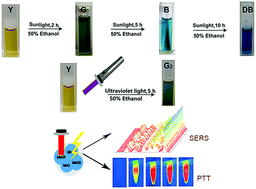Photo-induced synthesis of molybdenum oxide quantum dots for surface-enhanced Raman scattering and photothermal therapy†
Abstract
By means of a simple and photo-induced method, four colors of molybdenum oxide quantum dots (MoOx QDs) have been synthesized, using Mo(CO)6 as the structural guiding agent and molybdenum source. The as-prepared MoOx QDs display diverse optical properties due to the different configurations of oxygen vacancies in various nanostructures. Among them, crystalline molybdenum dioxide (MoO2) with a deep blue color shows the most intense localized surface plasmon resonance effect in the near-infrared (NIR) region. The strong NIR absorption endows MoO2 QDs with a high photothermal conversion efficiency of 66.3%, enabling broad prospects as a photo-responsive nanoagent for photothermal therapy of cancer. Moreover, MoO2 QDs can also serve as a novel semiconductor substrate for ultrasensitive surface-enhanced Raman scattering (SERS) analysis of aromatic molecules, amino acids and antibiotics, with SERS performance comparable to that of noble metal-based substrates. The therapeutic applications of MoO2 QDs open up a new avenue for tumor nanomedicine.



 Please wait while we load your content...
Please wait while we load your content...